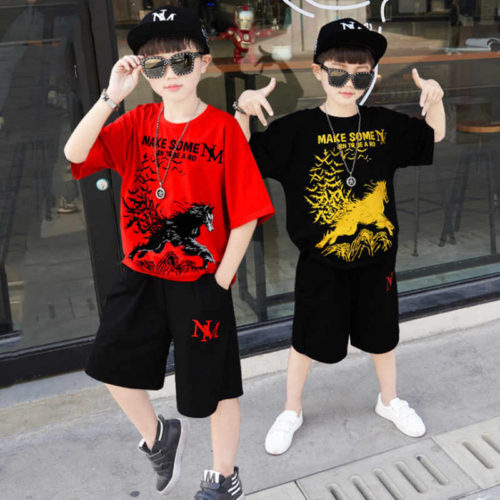Teaching kids to dress appropriately is vital. It helps them understand social norms and express themselves.
As parents, we want our children to make good choices in life. Dressing appropriately is one of those choices. It can be challenging to guide kids in this area. They often resist advice, wanting to follow their own style. But, with patience and the right approach, we can help them learn.
This blog will share practical tips. These tips will make the process smoother for both parents and children. You’ll find ways to encourage good habits and foster a sense of personal style. Let’s dive in and explore how to guide our kids in dressing appropriately.

Credit: www.instagram.com
Setting The Foundation
Teaching kids to dress appropriately is essential. Setting the foundation early helps build this important life skill. Children learn best through consistent guidance and practice. Let’s explore how to set this foundation effectively.
Importance Of Early Lessons
Starting early is crucial. Young children absorb habits quickly. Dressing appropriately becomes second nature with early lessons. They understand what fits different occasions. Simple tasks like choosing the right outfit for school or play help them learn. Early lessons also build confidence. Children feel proud when they dress themselves correctly. This pride boosts their self-esteem. They become more independent and responsible.
Role Of Parents
Parents play a big role in teaching kids to dress. Your guidance shapes their habits. Show them how to pick outfits for different events. Explain why certain clothes are suitable for specific places. Lead by example. Wear appropriate clothes yourself. Kids often copy their parents. Make dressing a fun activity. Let them choose from a few options. Praise their choices to encourage them. Be patient and consistent. Your efforts will pay off.
Choosing The Right Clothes
Teaching kids to dress appropriately involves more than just matching colors. The right clothes can build confidence and ensure comfort. It’s important to consider age, fit, and how the clothing feels.
Age-appropriate Choices
Children’s clothing should suit their age. For toddlers, choose clothes that allow free movement. Avoid clothes with small buttons or embellishments that can be a choking hazard. School-aged kids may prefer trendy or character-themed outfits. These make them feel connected to their peers.
Teenagers often have their own style. Encourage them to express themselves but guide them towards modesty and practicality. Balance is key. Ensure they understand the importance of dressing for different occasions.
Comfort And Fit
Comfort is crucial. Clothes should not be too tight or too loose. The right fit allows kids to move easily and feel good. Check for tags or seams that might irritate the skin. Soft fabrics are best for sensitive skin.
Consider the weather. In cold weather, layers are a good choice. In warm weather, lightweight fabrics work well. Make sure shoes fit well. Ill-fitting shoes can cause blisters and discomfort.
Teaching Weather Awareness
Teaching kids to dress appropriately for the weather is an essential skill. It’s important for their comfort and health. By understanding weather patterns, children can make better clothing choices.
Dressing For Seasons
Each season has different weather conditions. Explain the characteristics of each season. For example, summer is hot and requires lighter clothing. Winter is cold and needs warmer clothes. Show them how to check the weather forecast. Discuss how to dress accordingly. This helps them understand the need for different clothes throughout the year.
Layering Techniques
Layering is a useful skill for any weather. Teach them to start with a base layer. This could be a t-shirt or thermal wear. Add a middle layer for warmth, like a sweater. The outer layer protects from wind and rain, such as a jacket. Explain the benefits of each layer. Layers can be added or removed as needed. This keeps them comfortable throughout the day.
Explaining Dress Codes
Teaching kids to dress appropriately is a fundamental skill. One crucial aspect is explaining dress codes. Children need to understand why specific clothing is necessary in different settings. This knowledge helps them make better choices.
School Policies
Most schools have dress codes. These rules help create a safe and respectful environment. Explain these policies to your kids. Use simple language. Discuss why certain clothes are not allowed.
- Short skirts
- Revealing tops
- Offensive graphics
Show them examples of acceptable clothing. This might include:
- Plain t-shirts
- Jeans without rips
- Closed-toe shoes
Understanding these rules will help them comply. It also ensures they are comfortable and appropriate for school activities.
Special Occasions
Special events require different attire. This might include weddings, parties, or religious ceremonies. Explain the importance of dressing appropriately for these occasions. Use examples to illustrate your point.
| Occasion | Suggested Attire |
|---|---|
| Wedding | Dress or suit |
| Party | Casual but neat |
| Religious Ceremony | Modest clothing |
Explain why each event requires specific clothing. For instance, a wedding is a formal event. Therefore, a dress or suit is appropriate. This helps them understand the context and dress accordingly.
Encouraging Personal Style
Encouraging personal style is essential for kids. It helps them express themselves and build confidence. Supporting kids to find their own style can be fun and rewarding for both parents and children.
Finding Their Voice
Helping kids find their voice in fashion is important. Start by allowing them to choose their clothes. Guide them, but let them decide. This teaches decision-making and boosts their self-esteem.
- Offer choices: Present two or three outfits and let them pick.
- Encourage creativity: Mix and match different items to create new looks.
- Respect their preferences: Even if their choices are unusual, support their decisions.
Discuss their choices. Ask why they like certain clothes. This helps them articulate their preferences. Compliment their style to build confidence. Positive reinforcement goes a long way.
Balancing Trends
Trends can be exciting for kids. They see what others are wearing and want to join in. But not all trends are appropriate or practical.
- Educate about trends: Explain why some trends may not be suitable.
- Find a middle ground: Incorporate trends in a way that fits your family’s values.
- Set boundaries: Allow trendy pieces but balance with timeless items.
Use trends as a teaching moment. Explain the importance of comfort and function. Show how to blend trends with personal style. This helps kids make smart fashion choices.
Encouraging kids to dress appropriately while expressing their personal style is crucial. It fosters independence and confidence. Support them in finding their voice and balancing trends. This approach makes dressing up an enjoyable experience.
Fostering Independence
Teaching kids to dress appropriately can be a fun and rewarding experience. It is important to foster independence during this process. When children learn to dress themselves, it boosts their confidence and self-reliance. Here are some practical tips to help you guide them.
Simple Dressing Steps
Start with simple steps. Break down the dressing process into small, manageable tasks. Teach them to put on their socks first. Then, move to pants, shirts, and shoes. Use visual aids, like pictures or charts, to show each step. This makes it easier for kids to remember the order.
| Step | Action |
|---|---|
| 1 | Put on socks |
| 2 | Wear pants |
| 3 | Put on shirt |
| 4 | Wear shoes |
Practice And Patience
Practice makes perfect. Allow your child to practice dressing every day. Be patient and give them time to learn. Celebrate small victories to keep them motivated.
- Encourage daily practice.
- Be patient and supportive.
- Celebrate small achievements.
If they struggle, offer gentle guidance. Avoid taking over the task. This helps them learn from their mistakes. With time, they will gain the skills and confidence needed to dress themselves.
Safety Considerations
Teaching kids to dress appropriately involves more than just style. Ensuring safety is crucial. Children need guidance to pick clothes that keep them safe from potential hazards. Here are some key safety considerations to keep in mind.
Avoiding Choking Hazards
Small objects on clothes can pose choking risks. Buttons, beads, and sequins can come loose. Avoid these on young children’s clothes. Opt for items with zippers or Velcro instead. These are safer and easier for kids to manage.
Drawstrings on hoods or waists can also be dangerous. They can get caught on playground equipment or furniture. Choose clothes without drawstrings or those with short, secure ties.
Choosing Safe Materials
The material of a child’s clothing is important for safety and comfort. Natural fabrics like cotton are breathable and less likely to cause skin irritation. Avoid synthetic materials that can cause allergic reactions or skin rashes.
Also, consider the fire safety of fabrics. Some materials are more flammable than others. Choose flame-resistant or snug-fitting sleepwear to minimize fire risks. Check labels for safety standards.

Credit: hellscanyon.tours
Handling Resistance
Teaching kids to dress appropriately can be a challenge. Kids may resist, wanting to wear their favorite clothes, even if they are not suitable for the weather or occasion. Handling this resistance with patience and understanding is key. Below are some effective strategies to help manage this resistance.
Gentle Guidance
Start with gentle guidance. Explain why certain clothes are necessary for specific situations. Use simple language and relatable examples.
- Explain why a coat is needed on a cold day.
- Talk about why sandals are not good for rainy weather.
Make it a fun learning experience. Let them pick out clothes while guiding them towards appropriate choices. This way, they feel involved and less resistant.
Positive Reinforcement
Use positive reinforcement to encourage good choices. Praise them when they dress appropriately.
- Say things like, “Great job picking a warm sweater today!”
- Reward them with a favorite activity or a small treat.
Positive feedback helps kids feel proud of their choices. It encourages them to keep dressing appropriately.
In summary, handling resistance with gentle guidance and positive reinforcement can make teaching kids to dress appropriately a smoother process.
Creating A Routine
Creating a routine can help kids dress appropriately every day. Establishing a consistent daily routine teaches children the importance of preparation. It also makes mornings less stressful for parents and kids alike. Let’s break down the steps to create an effective routine.
Morning Prep
Morning preparation sets the tone for the day. Teach kids to wake up at a consistent time. This helps them feel more alert and ready to choose their outfits. Have a designated space for their clothes. This can be a drawer or a section of the closet. Make sure everything is organized and easy to reach. Lay out clothes the night before to save time. This reduces decision-making stress in the morning. Kids can focus on getting dressed without feeling rushed.
Evening Planning
Evening planning is equally important. It helps kids think ahead. Spend a few minutes each evening discussing the next day’s activities. This helps kids choose appropriate clothes. Check the weather together. This ensures they pick suitable outfits. Encourage kids to lay out their clothes before bedtime. Doing this helps them feel prepared and confident for the next day. It also saves precious time in the morning. Maintaining this routine makes dressing appropriately a habit.

Credit: www.facebook.com
Making Dressing Fun
Teaching kids to dress appropriately can be a challenge, but making the process fun can help. When kids enjoy what they’re doing, they’re more likely to engage and learn. Here are some tips to make dressing fun for kids.
Games And Rewards
Incorporating games and rewards can make dressing up an enjoyable activity. Try creating a simple game where kids race against the clock to dress themselves. You can use a timer and encourage them to beat their previous time. This not only makes the activity fun but also helps them practice dressing quickly and efficiently.
Setting up a reward system can also be effective. Create a reward chart where kids earn stickers or points for dressing themselves properly. Once they collect a certain number of stickers, they can receive a small prize. This method provides positive reinforcement and encourages them to keep improving.
| Activity | Reward |
|---|---|
| Dressing quickly | Sticker |
| Choosing appropriate clothes | Extra playtime |
| Completing the week with no reminders | Small toy |
Interactive Learning
Interactive learning can turn dressing into a fun and educational experience. Use dress-up dolls or apps that allow kids to mix and match outfits. This helps them understand which clothes are suitable for different occasions and weather conditions.
Another idea is to have a dress-up relay. Lay out different clothing items and have kids run to pick the correct ones for a given scenario. For example, if it’s a rainy day, they should choose a raincoat and boots. This activity makes them think about appropriate clothing choices in a playful way.
Storytelling can also be an engaging way to teach kids about dressing appropriately. Create stories where characters face different weather or events and need to choose the right clothes. Ask your child to help the characters make the right decisions. This not only makes learning fun but also enhances their decision-making skills.
Involving Kids In Shopping
Involving kids in shopping can be a great way to teach them about dressing appropriately. It helps them understand their preferences and learn about making choices. Including kids in shopping trips can also be a fun bonding experience. Here are some effective tips to get started.
Teaching Budgeting
Teaching kids about budgeting can be very beneficial. Start by giving them a small budget. Explain how much they can spend on clothes. Show them how to compare prices. This teaches them value and prioritizing needs over wants. Kids will learn to make smart choices. They will understand that money is not unlimited. This skill will help them in the future.
Letting Them Choose
Letting kids choose their clothes can build confidence. Give them options within your budget. Allow them to pick what they like. This fosters independence and creativity. They will feel more responsible for their choices. Guide them on what is appropriate for different occasions. Explain why certain clothes are better for specific events. This helps them understand appropriateness in dressing.
Understanding Social Norms
Teaching kids to dress appropriately involves more than just picking out nice clothes. It includes understanding social norms. Knowing what is suitable for different situations helps children blend in. It also boosts their confidence. This knowledge can be categorized into different aspects. Let’s explore them.
Appropriate Occasions
Knowing what to wear for different events is key. Here are some examples:
- School: Simple and comfortable clothes like jeans and t-shirts.
- Parties: Dressy outfits such as dresses or smart shirts.
- Sports: Activewear like shorts, sneakers, and t-shirts.
- Religious Events: Modest clothing that covers the body well.
| Occasion | Suggested Attire |
|---|---|
| School | Jeans and t-shirts |
| Parties | Dressy outfits |
| Sports | Activewear |
| Religious Events | Modest clothing |
Cultural Sensitivity
Different cultures have different dress codes. It is important to be aware of these differences. This helps in showing respect and understanding towards others. For instance:
- Asian Cultures: Often prefer modest and traditional clothing.
- Western Cultures: Casual wear is more accepted.
- Middle Eastern Cultures: Modesty is highly valued.
- African Cultures: Colorful and traditional attire is common.
Teaching kids about these cultural norms helps them to become more inclusive. It also helps them appreciate diversity.
Adapting With Age
Teaching kids to dress appropriately is an evolving task. As children grow, their needs and preferences change. Parents must adapt their guidance to match their child’s age and maturity.
Evolving Styles
Children’s fashion tastes change as they grow older. Young kids may prefer bright, cartoon-themed clothes. Older kids often seek trends and peer approval. Encourage their self-expression while guiding them on appropriateness. Offer choices that match their age and the occasion.
Growing Responsibilities
With age comes more responsibility. Younger kids need help choosing weather-appropriate clothes. Teach them to consider temperature and activities. Older kids can take on more responsibility. They should learn to plan outfits for school, sports, and special events. This builds independence and self-confidence.
Frequently Asked Questions
What Are Some Fun Ways To Teach Kids To Dress?
Use games and stories. Create a dress-up challenge. Make it fun and interactive.
How Can I Help My Child Understand Weather-appropriate Clothing?
Show examples of different outfits for different weather. Explain why each is suitable.
How Do I Teach My Child To Match Clothes?
Teach basic color coordination. Use simple patterns and examples. Practice with them regularly.
Why Is It Important For Kids To Dress Appropriately?
It promotes independence and self-confidence. Helps them understand social norms and weather conditions.
Conclusion
Teaching kids to dress appropriately can be rewarding. Start with simple guidelines. Encourage their choices and explain why certain clothes suit different occasions. Practice makes perfect. Patience and consistency help them learn faster. Celebrate their progress. A well-dressed child gains confidence and independence.
Follow these tips and create a fun learning experience. Happy dressing!







